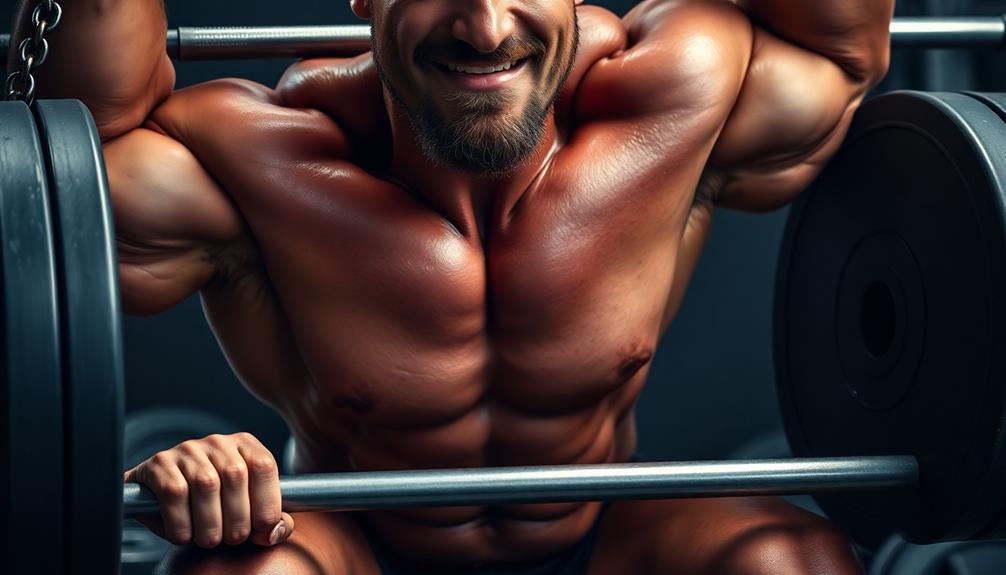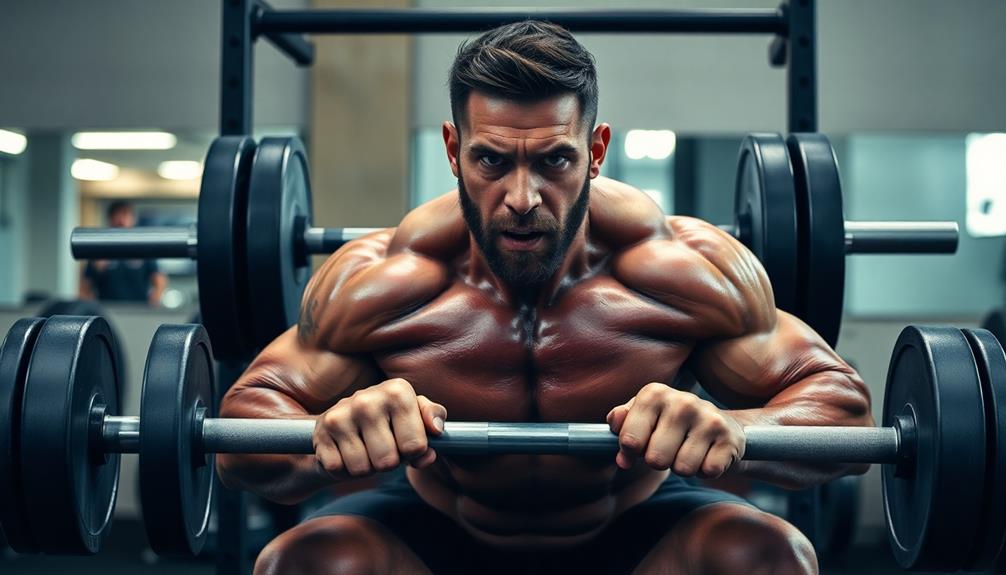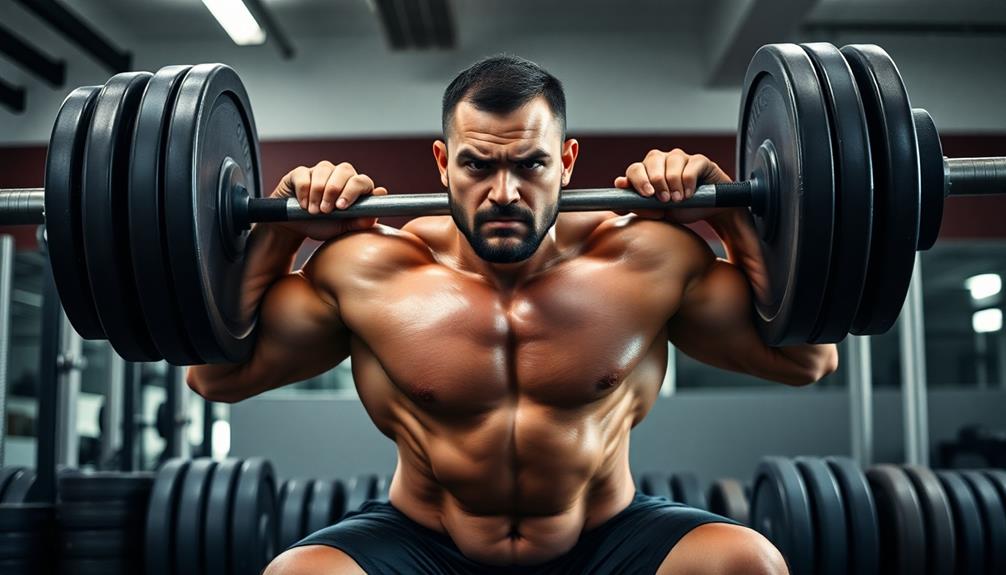To maximize strength with hypertrophy training as a powerlifter, focus on incorporating muscle growth exercises into your program. Use a mix of rep ranges, targeting both slow-twitch and fast-twitch muscle fibers. Include 6-12 reps per set for most exercises, with 3-4 sets per exercise and 12-20 sets per muscle group weekly. Balance hypertrophy work with strength training, and adjust volume based on recovery. Incorporate big lifts with more reps, single-joint exercises for weak areas, and variations of main lifts. Don't forget to prioritize proper nutrition and recovery. By understanding the benefits of muscle growth and integrating it effectively, you'll enhance your powerlifting performance.
Core Insight
- Incorporate hypertrophy-focused training phases with 6-12 reps per set to build muscle size and strength.
- Balance high-volume hypertrophy work with low-rep strength training for optimal powerlifting performance.
- Use variations of main lifts and accessory exercises to target specific muscle groups and weak points.
- Implement progressive overload in both hypertrophy and strength phases to continually challenge muscles.
- Prioritize proper nutrition, including high-protein intake, to support muscle growth and recovery.
Understanding Hypertrophy for Powerlifters

Muscle growth, strength gains, and powerlifting-specific training are the three keys to hypertrophy for powerlifters. To boost overall strength, focus on increasing muscle size by targeting both slow-twitch and fast-twitch muscle fibers. Do this with different rep ranges and training intensities. Resistance bands can help by providing variable resistance and targeting specific muscles.
To build strength, gradually increase the weight you lift over time. This progressive overload helps your body handle heavier loads, which is crucial for powerlifting. Adapt your hypertrophy training to powerlifting by prioritizing exercises that are similar to the squat, bench press, and deadlift.
Benefits of Muscle Growth

Building muscle offers powerlifters several key benefits. Increased muscle size leads to greater strength and improved leverage when lifting. Larger muscles also protect joints better, lowering the risk of injury.
The main benefits are:
| Benefit | Description | Powerlifting Impact |
|---|---|---|
| Strength | Bigger muscles are stronger | Lift more weight |
| Leverage | More muscle mass improves body mechanics | Better lift positioning |
| Joint Protection | Extra muscle cushions joints | Less likely to get injured |
| Metabolism Boost | Higher muscle mass speeds up metabolism | Easier to manage weight |
| Looking Good | Muscular appearance is enhanced | More confidence at meets |
Integrating Hypertrophy Into Powerlifting Programs

Powerlifters can add muscle-building training to their routines in a few key ways. One option is to set aside specific times, like the off-season, to focus on hypertrophy. During these phases, use higher reps (8-12) and moderate weights (60-75% of your 1-rep max). Choose isolation exercises to work muscles that help with your main lifts. For example, do leg extensions and hamstring curls to support your squats and deadlifts. Grass-fed whey protein supplements can give you high-quality protein to help your muscles recover and grow.
Keep doing your main lifts, too. Use variations with slightly higher reps to build muscle while keeping your form in check. You can also add hypertrophy work to your normal training by doing back-off sets after your heavy lifts. This lets you keep your strength up while still stimulating muscle growth.
Optimal Rep Ranges and Volume

For powerlifters doing hypertrophy training, it's important to know the best rep ranges and volume. Powerlifting usually uses low reps with heavy weights, but hypertrophy training uses higher reps. Do 6-12 reps per set for most exercises. You can change this a bit depending on the exercise and your goals.
Increase your total volume compared to pure strength training. Do 3-4 sets per exercise and 12-20 total sets per muscle group each week. This volume helps muscles grow without overworking your nervous system.
Balance hypertrophy work with strength training. You could do hypertrophy on certain days or as accessory work after main lifts. Change the volume and intensity based on how well you recover and your overall program.
Exercise Selection for Hypertrophy

When training for muscle growth, powerlifters should choose exercises differently than they would for pure strength. Keep the big lifts but add in single-joint exercises and variations that focus on specific muscles. This helps build overall muscle size, which can boost strength over time. High-protein oatmeals give key nutrients to power these hard workouts and help muscles grow. To pick the best exercises for growth, think about:
- Big lifts using more reps
- Single-joint moves for weak muscle groups
- Changed-up main lifts (like paused squats or deficit deadlifts)
- Extra work for problem areas
Periodization Strategies

Now that you've chosen the right exercises, it's time to plan out your training over time. Periodization is an important tool for getting the best muscle and strength gains possible. Here are some options to think about:
Linear Periodization:
If you're a beginner or intermediate lifter, start with more reps and less weight. Over time, gradually increase the weight while lowering the reps. This method is a solid choice for making consistent progress.
Undulating Periodization:
Switch up your training volume and intensity more often, sometimes even within the same week. This can help you avoid getting stuck on a plateau and keeps your workouts interesting.
Block Periodization:
Split your training into blocks that each focus on a specific goal, like muscle growth, strength, or peaking. Advanced lifters getting ready for a competition often use this approach.
Don't forget to include lighter deload weeks when needed. Be ready to change your periodization plan if your progress or recovery requires it. Try out different methods to see what gives you the best results.
Recovery and Nutrition Considerations

Your muscles need the right food and rest to grow from intense training. To do your best, focus on these key things:
- Eat enough protein (1.6-2.2g per kg of body weight each day)
- Eat a little more calories than you burn to help muscles grow
- Choose complex carbs for energy and recovery
- Drink plenty of water and fluids with electrolytes
After workouts, think about using carb powders that are easy to digest and quickly refill your energy stores. Look for good quality products that mix well so you can use them regularly.
Get enough sleep, trying for 7-9 hours each night. This lets your body repair and grow muscle. Have active rest days in your routine, with light cardio or stretching. This gets your blood flowing and reduces sore muscles. Don't forget to manage stress with things like meditation or yoga. High stress can make it harder to recover. By paying attention to food and recovery, you'll get the most out of your training and do well in powerlifting.
Common Myths and Misconceptions

It's a common myth that hypertrophy training will slow you down or make you weaker. Building muscle can actually improve your strength and power. You don't always need heavy weights to get stronger. Moderate weights and higher reps can help you grow muscle and get stronger too. Amino acids are important for repairing and growing muscle, which supports both hypertrophy and strength gains. Isolation exercises aren't just for bodybuilders. They can help fix muscle imbalances and strengthen weak areas. Hypertrophy training won't mess up your technique if you do it right. It can even improve your body awareness and control during lifts.
Frequently Asked Questions
How Long Should Hypertrophy Phases Last in a Powerlifting Program?
You'll typically want to run hypertrophy phases for 4-8 weeks in your powerlifting program. Maintaining a balance between muscle-building periods and strength-specific training is crucial. Adjust the duration based on your individual needs and competition schedule.
Can Hypertrophy Training Negatively Impact Technique for Competition Lifts?
Yes, hypertrophy training can temporarily affect your technique for competition lifts. You'll be using different rep ranges and intensities, which might impact your form. However, you can mitigate this by incorporating technique work throughout your hypertrophy phase.
What's the Best Way to Transition From Hypertrophy to Strength Phases?
You'll want to slowly change your focus from higher-volume, moderate-weight workouts to lower-volume, heavier lifts. Decrease your reps and sets while increasing the weight. Incorporate more competition-specific movements and practice your technique as you progress.
How Does Age Affect Hypertrophy Training for Powerlifters?
As you age, you'll experience slower muscle growth and recovery. You'll need to adjust your hypertrophy training by increasing rest periods, reducing volume, and focusing on quality over quantity. Don't forget to prioritize proper nutrition and sleep.
Are There Specific Supplements That Enhance Hypertrophy for Powerlifters?
Yes, there are supplements that can enhance hypertrophy. You'll benefit from protein powder, creatine, and BCAAs. They'll support muscle growth and recovery. However, don't rely solely on supplements; a balanced diet is essential for best results.

